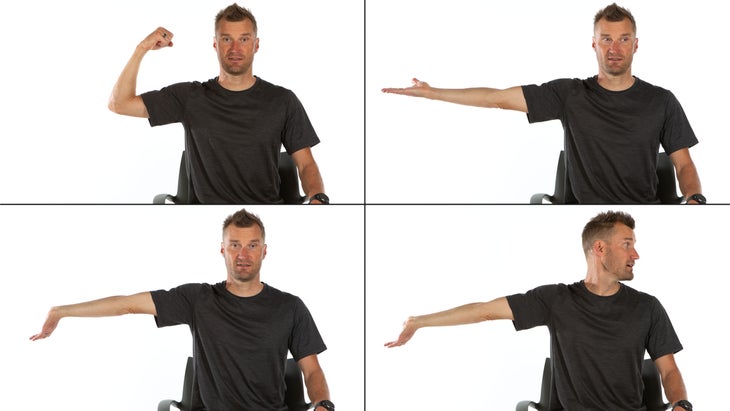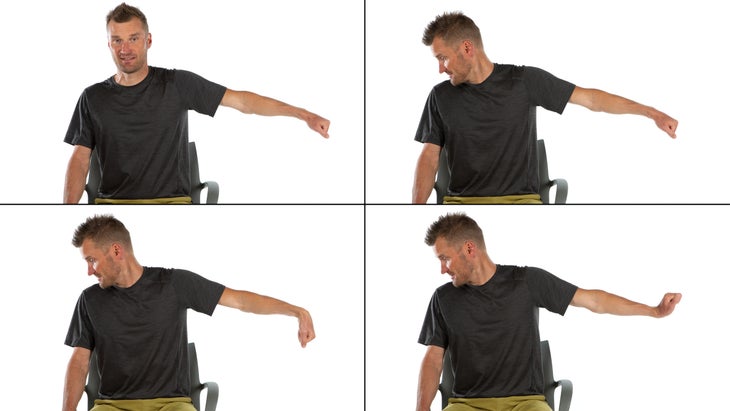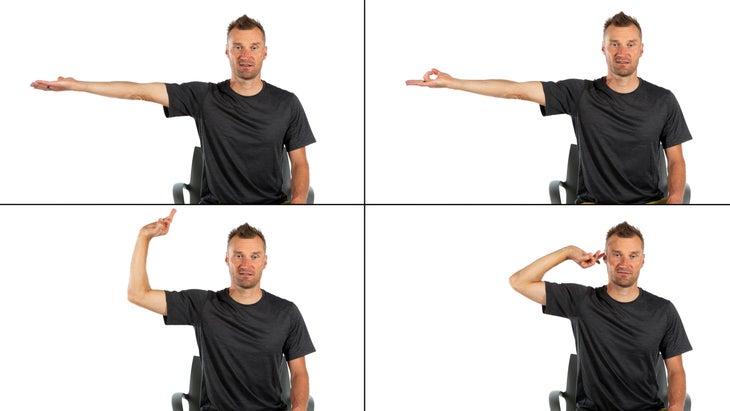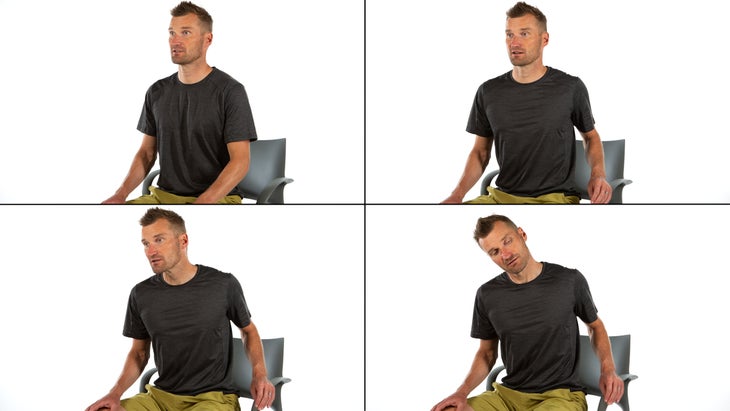New perk! Get after it with local recommendations just for you. Discover nearby events, routes out your door, and hidden gems when you sign up for the Local Running Drop.
You’ve probably seen a video (or 10, or 100, depending on how much time you spend on social media) of triathletes or cyclists who swear by “this one miracle move” to fix neck pain during and after a ride. The exercises performed in these videos look a little weird, but sometimes weird works. I should know – I’m a physical therapist and former pro triathlete, so I’ve spent plenty of time helping athletes conquer their cycling neck pain through neurodynamic mobilization – a fancy word for those weird exercises, more commonly known as “nerve flossing.”
When done correctly, these moves can bring a lot of relief to the tightness and tension triathletes often experience after a long ride. Let’s look at how nerve flossing works, plus how to incorporate these exercises into your recovery routine.
What is nerve flossing?
Nerve flossing refers to manual or exercise techniques designed to pull and release nerves, essentially “flossing” them through tissues to decrease pain, reduce adhesions, and improve mobility.
Peripheral nerves should normally “glide” through surrounding tissues, evenly distributing pulling forces throughout the nerve’s entire length. If fibrous adhesions or restrictions develop between the nerve and the sheath or tissues that surround it (typically due to acute or repetitive trauma and compression), normal gliding is prevented and forces are increased at the restricted areas, potentially leading to pain along the nerve’s path and decreased mobility in the neck, back, and extremities.
That’s where nerve flossing comes in. These exercises aim to restore normal neural and mechanical function by stretching adhesions, moving and altering pressure around nerves, decreasing edema, and improving circulation. Some techniques aim to create and release tension across the entire nerve, while others stretch one end at a time, depending on personal tolerance and the stage of healing. In cases where mobility restrictions aren’t fully explained by orthopedic soft tissue issues or sensations of pulling, pain, or paresthesias such as numbness or tingling are present, nerve flossing may be a valuable adjunct to treatment.
How does nerve flossing help with cycling neck pain?
Our necks consist of seven cervical vertebrae, with eight pairs of spinal nerves, labeled from C1 to C8, emerging from the spinal cord and exiting through small holes (foramen) between the vertebrae (C8 exits below the seventh cervical vertebrae and above the first thoracic vertebrae). These nerves provide motor control and sensation to the head, neck, shoulders, arms, and hands.
The upper cervical nerves (C1-C4) form the cervical plexus and mostly control head and neck movements (including speech and swallowing), provide sensation to the head, neck, and shoulders, and control the diaphragm to assist breathing. They also play a role in nervous system function. The posterior portions of the lower cervical nerves (C5-C8) supply sensation and motor control to the upper back, while the anterior portions form the brachial plexus (along with the T1 nerve root). The brachial plexus is a web of nerves that passes across the front of the neck and under the collarbone and pectoral muscles before branching to supply sensation and muscle innervation to the shoulders, arms, and hands.
So, what does this have to do with neck pain from cycling? Nerve tension or compression anywhere along the path from the neck to the hand can lead to pain, numbness, or tingling, with chronic neck pain and adverse neural tension often linked. The cervical spinal nerves, particularly those branching off of the brachial plexus and traveling down the arm, can be prone to adhesions.
The postures involved in cycling place the neck and nerves in vulnerable positions throughout their paths. At the neck level, prolonged cervical extension from looking ahead at the road tightens the space from which the spinal nerves emerge. Tension and restrictions in the neck and shoulder muscles from riding can create adhesions around the upper cervical nerves, leading to pain. Related tightness in the muscles of the front of the neck and shoulder can put pressure on the brachial plexus.
Further down the path, the median, radial, and ulnar nerves all travel through various small anatomical tunnels at the elbow, forearm, and wrist (such as the carpal tunnel at the wrist, the radial tunnel in the forearm, and the cubital tunnel at the elbow). The elbow and wrist positions and frequent gripping involved in cycling can all compress these nerves at these sites, leading to numbness and tingling in the forearms and hands.
Essentially, cycling stresses the upper body and neck muscles while putting the hands, arms, and neck in postures that increase the chances of adhesions between nerves and soft tissues and the development of adverse neural tension and pain. Nerve flossing has been shown to decrease pain and improve nerve conduction in patients with carpal tunnel syndrome and also improve cervical range of motion and function in patients with non-specific neck and upper back pain or cervical radiculopathy. So, it should be considered in the treatment toolbox for cycling-related neck pain and radicular symptoms.
4 nerve flossing exercises for cycling neck pain
Nerve glides targeting the median, radial, ulnar, and other cervical nerves are most commonly used to address neck and arm symptoms. Various techniques exist to tension and release or floss nerves along their roots by manipulating hand, arm, and neck movement. Several common ones are listed below.
Median nerve glide

This nerve glide is often helpful when neck pain is accompanied by symptoms in the thumb and first two fingers.
- Begin standing with your upper arm held at a 90-degree angle directly out to your side, elbow bent.
- With the palm facing up, slowly extend your elbow, then wrist and fingers, pointing the fingers down toward the floor.
- Rotate your head toward the opposite shoulder. A pulling sensation may be felt in the wrist, palm, and fingers.
- Hold briefly, then return to the starting position. Repeat 10 times.
Radial nerve glide

This nerve glide is indicated when symptoms are present in the neck or back of the forearm, wrist, and hand on the thumb side.
- Bring your arm directly out to your side, perpendicular to your body, then drop it down slightly (about 20-30 degrees) and make a fist.
- Side bend and rotate your head so that you’re looking down over the other shoulder.
- Flex your wrist down, hold it briefly, then extend it back up and pause again. Repeat 10 times.
Ulnar nerve glide

This nerve glide can offer relief when pain or pulling is felt in the neck, inside of the elbow, and/or ring and pinky fingers. Due to its location, the ulnar nerve is particularly prone to entrapment at the elbow in cyclists.
- Think of “giving yourself sunglasses.” Hold your arm out to your side and make an “OK” sign with your thumb and first finger.
- Rotate your forearm and hand so that your palm is facing the ceiling while bringing your pinky toward your ear. A pull may be felt in the pinky and ring finger. Hold briefly.
- Return to the starting position, and repeat 10 times.
Spinal accessory nerve glide

The spinal accessory nerve innervates a muscle in the front of the neck called the sternocleidomastoid and the trapezius muscles, which are commonly tight in cyclists. This nerve glide can help with pain, tingling, and tightness in the front of the neck and shoulders.
- Begin seated with your arms at your sides. Bring your shoulder back.
- Push your head forward while bending it down toward the opposite shoulder. A pull should be felt toward the front and outside of the neck.
- Return to the starting position, and repeat 10 times.
